Pros
Cons
Tour & Design
The Audio-Technica ATH-ANC3 headphones are made out of white (or black) plastic with silver detailing.
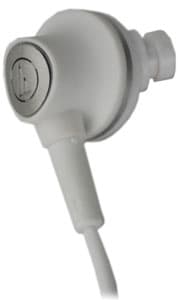
**The back of the ear buds look like they've been **
pinched, as opposed to the typical dome design.
The headphones have a symmetrical 'Y' design. This means the cord runs from the plug up to a neck split, then forks off into equal lengths, ending in the ear buds. The headphones feature three different sizes of gray, soft plastic sleeves.
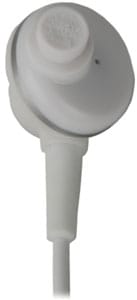
***This is a front-on view of the nozzle,
which is protected by white cloth.***
The control pendant is a few inches from the plug, and will safely reach your front pocket if you want to tuck it away. The pendant will let you turn the active noise cancellation feature on and off. When cancellation is on, the LED next to the power switch will glow red.

***From left to right, the control pendant's features are:
the monitor button, on/off switch, and power indicator.***

***The back of the control pendant has a shirt clip and
the trap door to the battery cavity.***
The cord ends in a standardd 1/8-inch plug. The plug has a substantial cord guard and the thick cord should resist wear and tear better than thinner cords.

***The plug is thin, so it should fit
into most recessed ports.***
Inside the ATH-ANC3 box, you'll find the headphones, a AA battery, an airplane adapter, two extra pairs of sleeves, and an extension cord.
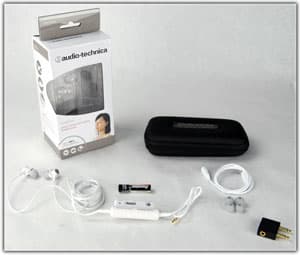
While there are a few areas on the ATH-ANC3 headphones that could become durability issues, for the most part they seem solid. One of the main areas we see problems in other headphones is where the cord connects to the plug (the cord can bend sharply at that junction if the headphones don't have some kind of guard.

There isn't much about the ATH-ANC3 headphones that are noteworthy in terms of aesthetics. First of all, there's never much space on in-ear headphones to do anything particularly eye-catchingly beautiful. The ATH-ANC3 headphones come in white and black, but we'd actually recommend the black ones for optimal aesthetic appeal. Unfortunately, thanks to Apple, white in-ear headphones are all being lumped into a 'standard headphones' label. While this means you'll be following a mainstream aesthetic, it also means everyone will assume you're wearing packed-in iPod headphones and no one will give your brand new $170 headphones a second glance. Again, however, this phenomena is something all in-ear headphones have to suffer through, since they're too small to make any real aesthetic statement.
The one (potential) aesthetic issue with the ATH-ANC3 headphones is the noise cancellation control pendant. At best, you just plop it in your pocket, which is the optimal route. At worst, you have a bulky control pendant clipped to your lapel or -- heaven forbid -- you walk around with a bit of plastic thumping against your leg. Although it's a bit big, to be fair, we really can't see the pendant shrinking much while maintaining its functionality or space for the battery. Chances are, however, the pendant will find its way safely inot your pocket, leaving you with an attractive, clean-looking pair of in-ears.
Performance
About our testing:
Our testing rig uses the same hardware and software employed by headphone manufacturers. The hardware, HATS (head and torso simulator) lets us get results that more closely resemble what users will actually experience. The software is SoundCheck by Listen Inc., which is an electroacoustic analysis program that lets us run the exact same battery of tests on all headphones we review. For more information on our tests, read this article.
**Frequency Response** *(3.32)* [

](https://www.reviewed.com/headphones/content/How-We-Test-149.htm#Frequency_Response)
How the test works:
To perform this test we first outfit HATS with the headphones. We then play a series of frequencies through the headphones, from 20kHz down to 100Hz, at an equal decibel level. We then plug in the headphones and see how they emphasize each frequency. The left channel is the green line, the right channel is the red line, and the dotted lines represent the limits of the scoring area. Outside of the scoring range, the data isn't 100% accurate, but it can be used to get a general sense of how the headphones will perform.
What we found:
The Audio-Technica ATH-ANC3 headphones didn't have the best frequency response score. As you can see, the bass is a bit over-emphasized. While listening, we found the bass often came close to sounding muddy, but never quite got there. Also, it looks like there's another significant peak around 7kHz, which is the attack (the initial sound of impact) of most drums. While we didn't particularly mind this boost, we can see how some would think the drums sound a bit too loud. After the 7kHz range, the graph drops off sharply, only to hike back up again in the 15kHz range, which should give a boost to cymbals.
How the Audio-Technica ATH-ANC3 compares:
The Audio-Technica ATH-ANC3 headphones certainly can't be accused of having a flat response curve. Unlike many of the other headphones below, the over-emphasized frequencies seem to be deliberate. That being said, the boosts are a bit over-zealous. We tend to favor a flat response curve, since it provides listeners with the closest representation of their music (it also doesn't assume the type of music you prefer listening to). If you like drums & bass music, the ATH-ANC3 headphones are good headphones for you.
If you want a flatter response, check out the 6isolators, which had a good score for a pair of in-ears. The Sennheiser MM 50 iPs feature a similar response curve to the ATH-ANC3 headphones, but don't emphasize the 7kHz range as much.

](https://www.reviewed.com/headphones/content/How-We-Test-149.htm#Frequency_Response)
How the test works:
To test distortion, we again play a series of frequences through the headphones and have HATS listen. Each frequency in the series, which ranges from 100Hz to 10kHz, is played back at a known decibel level. The below graph measures the gross difference between the ideal frequency that was played through the headphones and what HATS actually ended up hearing. The green line is the left channel, the red line is the right channel, and the Y-axis represents the the distortion as a percentage. Anything over 3% distortion is very noticeable.
What we found:
Bearing in mind that anything above 3% is noticeable, and that many good headphones hover very close to the zero line, it's clear the ATH-ANC3 headphones have a bit of a distortion problem. The majority of distortion is present for frequencies above the 1kHz mark. Given the over-emphasized bass, we're surprised to see the lower end is home to the lowest distortion levels.
This isnt' necessarily surprising; out of all the headphones we've tested, active-cancellers have a disproportionately higher chance of having issues with distortion. This makes sense when you consider that active cancellation works by playing back sound that has nothing to do with the music. Active cancellation can do a lot of things to mess with how your music sounds.
Being the curious cats we are, we also tested the ATH-ANC3 headphones with their active cancellation turned off. While there's significantly less distortion, there's still more than we typically see.
How the Audio-Technica ATH-ANC3 compares:
Given its poor performance, it's evident the ATH-ANC3 headphones don't compare well on this test. The Sennheiser MM 50 iP headphones are almost immaculate when it comes to distortion, and is currently the site leader on low distortion. Other active noise cancellers, like the Bose QC2 and Aurvana X-Fi headphones also had good distortion scores.

](https://www.reviewed.com/headphones/content/How-We-Test-149.htm#Tracking)
How the test works:
To test tracking, we again play a frequency sweep through the headphones. This time we're examining how loud each channel is. Perfect tracking would mean both channels are playing exactly the same frequency. On the below graph, anything above the zero line means the left channel is playing louder than the right; if the line dips below zero, the right channel is louder.
What we found:
The ATH-ANC3 headphones had pretty good tracking. As you can see, other than a few dips and peaks in the mid that are on the magnitude of a few decibels each, the line stays reasonably straight the entire time. Towards the end the graph gets a bit jagged, which is typical. Overall, the ATH-ANC3s are well balanced, but not perfect.
How the Audio-Technica ATH-ANC3 compares:
The ATH-ANC3 headphones scored in the middle of the pack here, but they're still in good shape in terms of usability. If you're looking for really top-of-the-line tracking, the 6isolators are about as close to balanced as you can get.
**Maximum Usable Volume** *(8.33)* [

](https://www.reviewed.com/headphones/content/How-We-Test-149.htm#Maximum_Usable_Volume)
**How the test works:
**To test the maximum usable volume, we perform our distortion test at increasing levels. As volume increases, so does distortion. What we're looking for is the maximum volume we can achieve while keeping distortion under 3%, the level at which it becomes irritatingly noticeable.
What we found:
We were able to squeeze 113dB from the ATH-ANC3 headphones before the sound became a questionable quality. This is a fine output level. We typically award maximum points to headphones capable of 120 dB, but any more than that is overkill unless you have/want a hearing problem.

](https://www.reviewed.com/headphones/content/How-We-Test-149.htm#Isolation)
How the test works:
To test isolation, we blast the headphones with pink noise, which sounds a lot like airplane ambience. Pink noise is where all frequencies are being played at an equal energy level, meaning higher frequencies are played at a lower decibel level than lower frequencies.
What we found:
We found that flipping noise cancellation on and off doesn't make a significant difference in the amount of sound blocked out. The place where you'll see the biggest improvement is with lower frequencies, with no real noticeable difference towards the high end.
How the Audio-Technica ATH-ANC3 compares:
The ATH-ANC3 headphones actually did worse on isolation that the other comparison headphones. Judging from our test results so far, active noise cancellation is great for over-ear or on-ear headphones. Active cancellation is inferior, however, to a good set of in-ears. Apparently the best way to block out noise at the moment is by plugging your ears.
It seems that, by employing active cancellation, the ATH-ANC3s have sacrificed some of the isolation that comes from solidly plugging up the ear. If you're looking for good active cancellation, stick to over-ear headphones with non-cloth ear cup pads. The non-cloth cup pads will provide a good seal with your head, provide a larger sound stage, and the active cancellation will often have a significant impact. If you're looking for the best isolation possible, go for in-ears with multi-flanged sleeves (triple-flanged will have the silhouette of a Christmas tree).

](https://www.reviewed.com/headphones/content/How-We-Test-149.htm#Isolation)
How the test works:
Our leakage test measure the amount of sound that escapes from the headphones to permeate the air around you. What we do is fit the headphones in HATS, then play back pink noise through the headphones. We place a microphone a set distance away from HATS to pick up any noise that's leaking out. As with all our tests, if you want to learn more about our procedures, click the orange info button to the right of the section title.
What we found:
The ATH-ANC3 headphones aren't the best headphones for keeping your music to yourself. They actually scored lower than the other in-ears we've reviewed, but above the typical pair of on-ears or over-ears. They aren't terrible at controlling leakage, however. If you were sitting next to someone on a bus or train, chances are the ambience will drown out most of the playback that does escape. If you're in a quiet place like a library or museum, chances are you'll be leaking more sound than you'd like.
In Use
For this and the following score, we customize the headphones to best suit our heads, then give them a wear. We highly recommend wearing any set of headphones for at least an hour, if not the entire duration of a typical listening session, before you decide to keep them.
In general, the ATH-ANC3 headphones felt about as comfortable as the average, soft-plastic-sleeve-having set of in-ears. The sleeves themselves aren't particularly rigid, so they didn't create much pressure, and the three sizes should help quite a few people get a good fit.
Also, joggers will rejoice to find out that these headphones will stay in while they train for their marathon, but they might find the control pendant to be annoying. Actually, we think the ATH-ANC3 headphones are actually better for joggers than typical in-ears: if you leave active cancellation off, If you do plan on wearing noise-cancelling, in-ear headphones while you're out on the street, be sure to be careful: the world outside is filled with dangerous cars, murderous trains, and Lovecraftian horrors waiting to spring on the headphone-wearing unfortunate.
After six-hour session, our opinions towards the ATH-ANC3 headphones didn't change much. Typically in-ear headphones with soft plastic sleeves are simply not hard enough to make you feel overly uncomfortable (above and beyond the 'I have stuff in my ears' discomfort).
**Cable Connectivity***(7.57)*
The ATH-ANC3 headphones measure about 3 feet, 9 and 3/8 inches (1.15m) from cord guard to cord guard. This is a good length for a set of in-ears, and should be enough to reach your jeans pocket, even if you have a particularly long torso. Attach the included extension cord and suddenly you've got a full 5 feet, 8 and 9/16 inches (1.74m). This is one of the longest cords we've seen on a pair of in-ears.
As a set of in-ear headphones, the ATH-ANC3s are far more portable than the average pair of over-ears or on-ears. They aren't, however, more portable then one of their more typical in-ear brethren. The reason for this is two-fold. First, the control pendant is a bit bulky. If we were to measure the portability of each pair of headphones based solely on volume, the ATH-ANC3s' pendant would half their score. As it is, even though they're one of the lesser-portable sets of in-ears, they're still really portable.
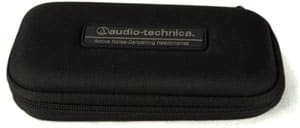
The case has a firm, slightly epidermis.
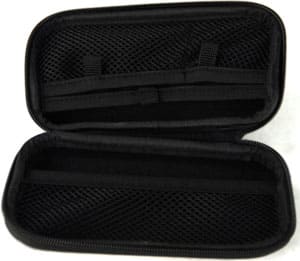
This is the inside of the case, which is littered with mesh pockets.
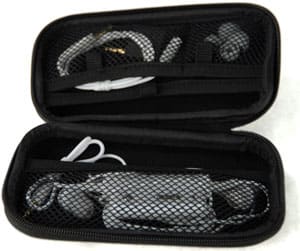
***This is the case with all included accessories shoved into *
*pockets. The headphones themselves are a bit too big
for the largest pocket.***
The ATH-ANC3 headphones aren't the most customizable headphones we've come across. Typically in-ear headphones can get a good score here by adding a decent selection of sleeves. The ATH-ANC3 has a set of small, medium, and large sleeves, which should provide a good chunk of users with a fit. Some other headphones, however, like the Etymotic Research 6isolators, or Shure SE210s came with quite a few sleeves of different shapes and sizes.
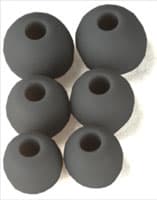
Three different sleeve sizes is *
*standard fare.
The ATH-ANC3 headphones don't provide users with many tools or options for cleaning or maintenance. We've seen some in-ears come with cleaning tools, or replaceable nozzle guards (a wax insert to keep your own, grosser version out of there). The only option you have is to remove the sleeves, which is a standard feature on in-ears.
**Other Features***(6.50)*
Battery Dependency
While the active noise cancellation feature requires a single AAA battery to operate, the headphones will work as headphones even if there's no battery inserted. This is far, far preferrable to Bose or Sony offerings, which won't play back music without the battery.
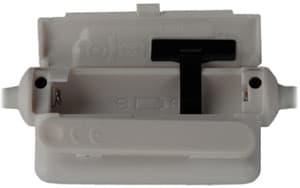
**The lid of the battery cavity is held on by a thin ribbon of plastic. **
Active Noise Cancellation

The ATH-ANC3 headphones' most interesting feature is their noise cancellation. Typically active noise cancellation has been the territory of over-ear or on-ear headphones since they have inferior passive noise cancellation (they don't plug your ears). The active cancellation is controlled via the in-line pendant. Unlike many other active-cancellers, the ATH-ANC3 headphones can switch their cancellation feature on and off via the appropriately labeled switch. To the power switch's right is an LED that will glow red when cancellation is turned on. To the power switch's left is the MONITOR button, which, contrary to its all-caps spelling would indicate, will quiet your music and turn off active cancellation for the duration its pressed.
Value & Comparisons

Value*(4.00)*
At $170, the ATH-ANC3 headphones are a bit on the pricy side. We wouldn't necessarily recommend the ATH-ANC3 headphones to people who are looking for active cancellation, since the feature honestly doesn't do much. We would, however, recommend anyone who likes drum-and-bass-heavy music to at least give these a shot.

[

Etymotic Research 6isolator](https://www.reviewed.com/headphones/content/Etymotic-6isolator-Headphones-Review.htm) - The 6isolators are the best isolating headphones we have reviewed thus far, including headphones with active noise cancellation. They also have better overall audio quality, cost $30 less, and have a much wider selection of sleeves included. If you're looking for headphones with a dynamic frequency response, or if you're actually looking for a pair of in-ears that let a lot of external sound in, then consider teh ATH-ANC3 headphones. In most cases, however, we'd recommend the 6isolators.
[

Sennheiser MM 50 iP](https://www.reviewed.com/headphones/content/sennheiser_mm-50-ip-Headphones-Review-547.htm) - The Sennheiser MM 50 iP headphones have great audio quality, isolate fairly well for a pair of in-ears, and are about as comfortable as the ATH-ANC3s. The MM 50 iPs also only cost $100. Relative to their excellent performance, this is downright cheap. The one area where the ATH-ANC3s might win a few fans is with the actual sound of the headphones. We can see people who like drum/bass-heavy songs thinking the MM 50 iP headphones sound a bit flat. The MM 50 iPs and ATH-ANC3s both have similar trends with the frequencies they emphasize, but the ATH-ANC3 headphones over-emphasize drums. We'd recommend giving each a listen before buying, but we'd tend to recommend the MM 50 iPs.
[

Apple iPod In-ear Headphones](https://www.reviewed.com/headphones/content/Apple-In-ear-Headphones-Review-269.htm) - Contrary to popular audiophile belief, the Apple iPod In-ear Headphones (this is their full, non-serial-number name) don't have horrible audio quality. They are a pain to actually wear, however, since the ear buds precariously balance outside your ear canal rather than fitting snugly inside. This means any tugging on the cord or sudden movements could pull the buds out of position. These annoyingly constant readjustments coupled with the sharp decrease in perceived audio quality when they're out of place will be deal-breakers for many. In this match-up, unless you're a bargain shopper and there aren't any other headphones in the room, we'd recommend the ATH-ANC3 headphones over the iPod In-ears.
[

Bose QuietComfort 3](https://www.reviewed.com/headphones/content/Bost-QuietComfort3-Headphones-Review.htm) - The Bose QuietComfort series of headphones made 'noise cancellation' an industry buzzword. This being said, the QuietComfort series' implementation of the noise-cancellation feature isn't aging well. The feature is dependent on a battery and the headphones won't play back your music without some juice. Also, you can't toggle the feature on and off, so if you're listening to music, you're burning battery life. The ATH-ANC3 wins here.
Aside from other, more subjective issues that this comparison must encompass, such as on-ear versus in-ear or intended use, we'd probably recommend the ATH-ANC3 headphones over the QC3s in most cases. While the QC3s are a bit better at isolation, have better overall audio quality, and come with more extras, they're simply far too overpriced for what they actually deliver to consumers. The ATH-ANC3 headphones cost less than half what the QC3s do ($350 vs. $170).
[

Creative Aurvana X-Fi](https://www.reviewed.com/headphones/content/Creative-Aurvana-X-Fi-Headphones-Review-496.htm) - This comparison is a bit of a toss-up. If you want good active cancellation and that's all, the X-Fis deliver better than the Bose headphones or the ATH-ANC3s. If you're looking for portable, the X-Fis obviously can't compete. If price is a factor, we'd have to side with the ATH-ANC3s again, simply because they provide you more for your money.
Conclusion
Conclusion

The Audio-Technica ATH-ANC3 headphones are an interesting set of in-ears. They didn't sparkle on our audio tests, they're more versatile than the average set of in-ears, and they'd probably be better off without their main feature. Though they're far from perfect, the ATH-ANC3 headphones are by no means a pair of headphones you should totally discount when you're looking for a new set of in-ears. We've said it a few times in the review, but we can really see the ATH-ANC3s being enjoyed by fans of drums & bass, or other genres that focus on those instruments. Regardless, we think they're worth a listen. Also, if you're a jogger but want to hear those oncoming trucks and trains, the ATH-ANC3s are a pair of in-ears that won't fall out easily but will still let you hear a great deal of outside noise.

Audiophiles will probably balk at the over-emphasized segments on our frequency response chart. Active cancellation will screw around with the sound too much, either by adding distortion or noise.
While they're not as portable as other in-ears, the ATH-ANC3 headphones are still very portable. They don't isolate as well as other in-ears, even with active cancellation on, which can either be good or bad, depending on how you want to use them.
We're a bit torn on this one, but due to their poor noise cancellation, we're disinclined to recommend them for airplane rides. In most cases, you'd be better off with regular in-ear headphones.
Although the lengthy cord can certainly let you hook up your ATH-ANC3s to a nearby stereo in a pinch, we typically don't recommend in-ear headphones for a home theater setup. Over-ears are the way to go, since they can provide a much more immersive soundstage and often have neat features like surround sound.
Meet the tester
Mark Brezinski works on the Home Team, reviewing refrigerators, minifridges, dishwashers, washing machines, dryers, air conditioners, air purifiers, and fans.
Checking our work.
Our team is here to help you buy the best stuff and love what you own. Our writers, editors, and experts obsess over the products we cover to make sure you're confident and satisfied. Have a different opinion about something we recommend? Email us and we'll compare notes.
Shoot us an email